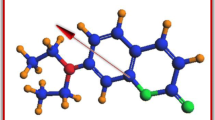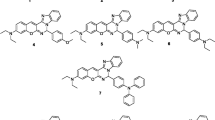Abstract
The absorption and fluorescence spectra of laser dye, 10-acetyl-2,3,6,7-tetrahydro-1H,5H,11H-pyrano[2,3-f]pyrido[3,2,1-ij]quinolin-11-one [C-334], are recorded. The ground-state dipole moments (μg) were determined from density functional theory (DFT) computations, Guggenheim’s, and solvatochromic methods. The excited-state dipole moments (μe) were determined from Lippert’s, Bakhshiev’s, Kawski-Chamma-Viallet’s, and McRae’s equations. The μe values are found to be higher than μg values and this suggest that the probe molecule is more polar in the excited state. The absorption maxima and emission maxima of C-334 undergo bathochromic shift as the polarity of the solvent increases and indicates that the transitions involved are π → π*. The change in dipole moment (Δμ) and the angle between μe and μg is calculated. The absorption and fluorescence emission of the probe C-334 were investigated theoretically with the help of Gaussian 09W for all the studied solvents by using time-dependent (TD)-DFT combined with conductor-like polarizable continuum model (CPCM) solvation model and were compared with the experimental results. Further, the ground- and excited-state dipole moments were also estimated for all the studied solvents by using CPCM solvation model and are compared with the experimental results. The HOMO-LUMO energy gaps computed using DFT and from absorption threshold wavelengths are found to be in order with each other. The chemical hardness (η) of the probe molecule is estimated and the results suggest the soft nature of the molecule. Further, the reactive centers like electrophilic site and nucleophilic site were identified with the help of molecular electrostatic potential (MESP) 3D plots using DFT computational analysis.











Similar content being viewed by others
References
N.K. Hamdi, M.M. Chebli, H. Grib, M. Brahimi, A.M.S. Silva, Synthesis DFT/TD-DFT theoretical studies and experimental solvatochromic shift methods on determination of ground and excited state dipole moments of 3-(2-hydroxybenzoyl) coumarins. Journal of Molecular Structure 1175, 811–820 (2019)
N. Khanapurmath, M.V. Kulkarni, L. Pallavi, J. Yenagi, J. Tonannavar, Solvatochromic studies on 4-bromomethyl-7-methyl coumarins. Journal of Molecular Structure 1160, 50–56 (2018)
S. Samundeeswari, M.V. Kulkarni, J. Yenagi, J. Tonannavar, Dual fluorescence and solvatochromic study on 3-acyl coumarins. J. Fluoresc. 27, 1247–1255 (2017). https://doi.org/10.1007/s10895-017-2052-z
J. Basavaraj, H.M. Sureshkumar, S.R. Inamdar, M.N. Wari, Estimation of ground and excited state dipole moment of laser dyes C504T and C521T using solvatochromic shifts of absorption and fluorescence spectra. Spectrochim. Acta Part A-Molecular and Biomolecular Spectro 154, 177 (2016)
U.S. Raikar, V.B. Tangod, S.R. Mannopantar, B.M. Mastiholli, Ground and excited state dipole moments of coumarin 337 laser dye. Optics Communication 283, 4289–4292 (2010)
J. Basavaraj, S.R. Inamdar, H.M. Sureshkumar, Solvent effects on the absorption and fluorescence spectra of 7-diethylamino-3-thienoylcoumarin: Evaluation and correlation between solvatochromism and solvent polarity parameters. Spectrochim. Acta Part A-Molecular and Biomolecular Spectro 137, 527 (2015)
E.J. Schitschek, J.A. Trias, P.R. Hammond, R.A. Henry, R.L. Atkins, New laser dyes with blue-green emission. Optics Communication 16, 313–316 (1976)
C. Parkanyi, M.S. Antonious, J.J. Aaron, M. Buna, A. Tine, L. Cissa, Determination of the first excited singlet state dipole moments of coumarins by the solvatochromic method. Spectro. Letters 27, 439–449 (1994)
E. Perez-Rodriguez, J. Aguilera, F.L. Figueroa, J. Expt, Tissular localization of coumarins in the green alga Dasycladus vermicularis (Scopoli) Krasser: a photoprotective role? Botany 54, 1093 (2003)
K.H. Drexhage, Structure and properties of laser dyes, (Springer-Verlag, Berlin, 1973)
J. Thipperudrappa, D.S. Biradar, S.R. Manohara, S.M. Hanagodimath, S.R. Inamadar, R.J. Manekutla, Solvent effects on the absorption and fluorescence spectra of some laser dyes: Estimation of ground and excited-state dipole moments. Spectrochim. Acta Part A- Molecular and Biomolecular Spectro 69, 991–997 (2008)
W.R. Shermon, E. Robins, Fluorescence of substituted 7-hydroxycoumarins. Anal. Chem. 40, 803–805 (1968)
A. Evangelos, P.D. Andrew, Convenient microscale synthesis of a coumarin laser dye analog. Journal of Chemical Education 83(2), 287 (2006)
A. Lacy, R. Kennedy, Studies on coumarins and coumarin-related compounds to determine their therapeutic role in the treatment of cancer. Current Pharmaceutical Design 10, 3797–3811 (2004)
V.U. Jeankumar, R.S. Reshma, R. Janupally, S. Saxena, J.P. Sridevi, B. Medapi, P. Kulkarni, P. Yogeeswari, D. Sriram, Enabling the (3 + 2) cycloaddition reaction in assembling newer anti-tubercular lead acting through the inhibition of the gyrase ATPase domain: lead optimization and structure activity profiling. Organic & Biomolecular Chemistry 13, 2423–2431 (2015)
D. Yu, M. Suzuki, L. Xie, S.L. Morris-Natschke, K.H. Lee, Recent progress in the development of coumarin derivatives as potent anti-HIV agents. Med. Res. Rev. 23, 322–345 (2003)
R.D. Thornes, D.W. Edlow, S. Wood, Inhibition of locomotion of cancer cells in vivo by anticoagulant therapy. I. Effects of sodium warfarin on V2 cancer cells, granulocytes, lymphocytes and macrophages in rabbits. The Johns Hopkins Medical Journal 123, 305 (1968)
D.Z. N’u˜nez, P. Barrias, G.C. Jir’on, M.S.U. Za˜nartu, C.L. Alarc’on, F.E.M. Vieyra, C.D. Borsarelli, E.I. Alarcon, A. Asp’ee, A typical antioxidant activity of non-phenolic amino-coumarins. RSC Advances 8, 1927 (2018)
M. Vaculovicova, S. Dostalova, V. Milosavljevic, P. Kopel, V. Adam, R. Kizek, Characterization of carbon quantum dots by capillary electrophoresis with laser-induced fluorescence detections. J. Metallomics & Nanotechno. 3, 97 (2015)
R. Konecna, H. Viet Nguyen, M. Stanisavljevic, I. Blazkova, S. Krizkova, M. Vaculovicova, M. Stiborova, T. Eckschlager, O. Zitka, V. Adam, R. Kizek, Doxorubicin encapsulation investigated by capillary electrophoresis with laser-induced fluorescence detection. Chromatographia 77, 1469–1476 (2014)
M.H. Kim, H.H. Jang, S. Yi, S.K. Chang, M.S. Han, Coumarin-derivative-based off–on catalytic chemodosimeter for Cu2+ ions. Chemical Communications 4838 (2009)
J. Huang, V. Bekiari, P. Lianos, S. Couris, Study of poly(methyl methacrylate) thin films doped with laser dyes. J. Luminescence 81, 285–291 (1999)
C. Reichardt, Solvents and Solvent Effects in Organic Chemistry, 3rd edn. (Wiley-VCH, New York, 2004)
U.P. Raghavendra, M. Basanagouda, R.M. Melavanki, R.H. Fattepur, J. Thipperudrappa, Solvatochromic studies of biologically active iodinated 4-aryloxymethyl coumarins and estimation of dipole moments. J. Mol. Liq. 202, 9–16 (2015)
S.S. Patil, G.V. Muddapur, N.R. Patil, R.M. Melavanki, R.A. Kusanur, Fluorescence characteristics of aryl boronic acid derivative (PBA). Spectrochim. Acta Part A- Molecular and Biomolecular Spectro 138, 85–91 (2015)
S.K. Patil, M.N. Wari, P.C. Yohannan, S.R. Inamdar, Determination of ground and excited state dipole moments of dipolar laser dyes by solvatochromic shift method. Spectrochim. Acta Part A- Molecular and Biomolecular Spectro 123, 117–126 (2014)
G.V. Muddapur, N.R. Patil, S.S. Patil, R.M. Melavanki, R.A. Kusanur, Estimation of ground and excited state dipole moments of aryl boronic acid derivative by solvatochromic shift method. J. Fluoresc. 24, 1651–1659 (2014)
J.S. Kadadevarmath, G.H. Malimath, N.R. Patil, H.S. Geetanjali, R.M. Melavanki, Solvent effect on the dipole moments and photo physical behaviour of 2,5-di-(5-tert-butyl-2-benzoxazolyl) thiophene dye. Canadian Journal of Physiology and Pharmacology 91, 1107–1113 (2013)
J.R. Manekutla, B.G. Mulimani, S.R. Inamdar, Solvent effect on absorption and fluorescence spectra of coumarin laser dyes: Evaluation of ground and excited state dipole moments. Spectrochim. Acta Part A- Molecular and Biomolecular Spectro 69, 419 (2008)
D.S. Biradar, B. Siddlingeshwar, S.M. Hanagodimath, Estimation of ground and excited state dipole moments of some laser dyes. J. Mol. Struct. 875, 108–112 (2008)
J. Czekella, Two electro optical methods for determination of dipole moments of excited molecules. Chimia 15, 26 (1961)
J. Czekella, Elektrische Fluoreszenzpolarisation: Die Bestimmung von Dipolmomenten angeregter Moleküle aus dem Polarisationsgrad der Fluoreszenz in starken elektrischen Feldern. Z. Elaktrochem. 64, 1221 (1960)
M.P. Hass, J.M. Warman, Photon-induced molecular charge separation studied by nanosecond time-resolved microwave conductivity. Chemistry and Physics of Lipids 73, 35–53 (1982)
J.R. Lombardi, Correlation between structure and dipole moments in the excited states of substituted benzenes. Journal of the American Chemical Society 92, 1831–1833 (1970)
E.A. Guggenheim, The computation of electric dipole moments. Transactions of the Faraday Society 47, 573 (1951)
L. Naik, N. Deshapande, I.A.M. Khazi, G.H. Malimath, Resonance energy transfer studies from derivatives of thiophene substituted 1,3,4-oxadiazoles to coumarin-334 dye in liquid and dye-doped polymer media. Brazilian Journal of Physics 48, 16–24 (2017). https://doi.org/10.1007/s13538-017-0540-x
E.Z. Lippert, Spektroskopische Bestimmung des Dipolmomentes aromatischer Verbindungen im ersten angeregten Singulettzustand. Zeitschrift für Elektrochemie 61, 962 (1957)
N.G. Bakhshiev, Universal intermolecular interactions and their effect on the position of the electronic spectra of molecules in 2-component solutions. Optika i Spektroskopiya 16(5), 821 (1964)
A. Kawski, On the estimation of excited state dipole moments from solvatochromic shifts of absorption and fluorescence spectra. Zeitschrift für Naturforschung 57A, 255 (2002)
U.S. Raikar, V.B. Tangod, B.M. Mastiholli, S. Sreenivasa, Solvent effects and photophysical studies of ADS560EI laser dye. African Journal of Pure and Applied Chemistry 4(9), 188 (2010)
K.B. Akshaya, V. Anitha, L.L. Prajwal, K. Rekakumari, G. Louis, Synthesis and photophysical properties of a novel phthalimide derivative using solvatochromic shift method for the estimation of ground and singlet excited state dipole moments. Journal of Molecular Liquids 224, 247–254 (2016)
A. Roshmy, V. Anita, G. Louis, N. Aatika, Estimation of ground state and excited state dipole moments of a novel Schiff base derivative containing 1,2,4-triazole nucleus by solvatochromic method. J. Mol. Liq. 215, 387 (2016)
S.R. Manohara, V.U. Kumar, G.L. Shivakumaraiah, Estimation of ground and excited-state dipole moments of 1, 2-diazines by solvatochromic method and quantum-chemical calculation. J. Mol. Liq. 181, 97–104 (2013)
R.G. Pearson, Chemical Hardness (Wiley - VCH, Weinheim, 1997)
Acknowledgements
The authors are thankful to the authorities of USIC, KUD, for providing the instrumental facility for our research work. One of the authors (CVM) is thankful to the Principal Prof. B.P. Urakadli and staff, Government First Grade College Hubballi, for their continuous support and encouragement.
Author information
Authors and Affiliations
Corresponding author
Rights and permissions
About this article
Cite this article
Maridevarmath, C.V., Naik, L. & Malimath, G.H. Dielectric, Photophysical, Solvatochromic, and DFT Studies on Laser Dye Coumarin 334. Braz J Phys 49, 151–160 (2019). https://doi.org/10.1007/s13538-018-00628-3
Received:
Published:
Issue Date:
DOI: https://doi.org/10.1007/s13538-018-00628-3




